Western Digital to Use 3D ReRAM as Storage Class Memory for Special-Purpose SSDs
by Anton Shilov on August 12, 2016 8:00 AM EST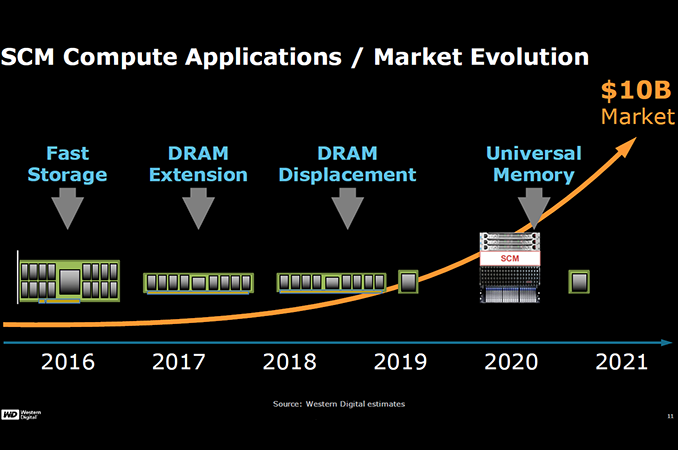
At the Flash Memory Summit this week, Western Digital announced that it intends to use 3D Resistive RAM (ReRAM) as storage class memory (SCM) for its future special-purpose ultra-fast SSDs. The company did not reveal any actual timelines for appropriate products, nor their specifications. However, what is important is the fact that Western Digital decided to use SanDisk’s long-discussed ReRAM along with 3D manufacturing tech to build the aforementioned special-purpose SSDs.
The amount of data that the world produces totals several zettabytes per year, which creates two challenges for the high-tech industry: one is to store the vast amounts of data more or less cost-efficiently, another is to process this data efficiently from power consumption point of view. Modern SSDs and HDDs can store plenty of information (10 to 15 TB for top-of-the-range models) and modern CPUs can process a lot of data due to increasing number of cores. However, delivering the right data to those cores poses further challenges: if the necessary data is located on an HDD/SSD, fetching them from there takes a lot of time on computer timescales (e.g., 100,000 – 10,000,000 ns) and consumes a lot of energy. Meanwhile, increasing the amount of DRAM per server is not always feasible from economic point of view.
To address the challenge, the industry came up with idea of non-volatile SCM, which would sit between DRAM and storage devices and deliver much greater performance, endurance and lower latency (e.g., 250 – 5,000 ns) than NAND while costing a lot less than DRAM in terms of per-GB prices. Historically, different companies demonstrated various types of memory, which could be used as SCM (originally, this class of devices was classified as a replacement tech for NAND flash), including conductive-bridging RAM (CBRAM), phase-change memory (PCM), magnetoresistive RAM (MRAM), resistive RAM (ReRAM) and some others. All of these technologies have their own peculiarities like performance and costs (and none of them could beat NAND in terms of per-GB cost), but SanDisk has been working for years on bringing ReRAM to the market.
Fundamentally, ReRAM (also sometimes called RRAM) works by changing the resistance across a dielectric material by electrical current (which is why 3D XPoint is considered as a proprietary implementation of ReRAM). The resistance can be measured and considered as “0” or “1”. On paper, the technology enables higher performance and endurance when compared to NAND flash, but finding the right materials and architecture for ReRAM has taken engineers many years.
Without making any significant announcements this week, Western Digital indicated that it would use some of the things it has learnt while developing its BiCS 3D NAND to produce its ReRAM chips. The company claims that its ReRAM will feature a multi-layer cross-point implementation, something it originally revealed a while ago.
Perhaps, the most important announcement regarding the 3D ReRAM by Western Digital is the claim about scale and capital efficiency of the new memory. Essentially, this could mean that the company plans to use its manufacturing capacities as well as its infrastructure (testing, packaging, etc.) in Yokkaichi, Japan, to make 3D ReRAM. Remember that SCM is at this point more expensive than NAND, hence, it makes sense to continue using the current fabs and equipment to build both types of non-volatile memory so ensure that the SCM part of the business remains profitable. IMFT does the same thing with its SCM: it uses its fab in Lehi, Utah, to produce 3D XPoint memory, but does not reveal specifics about the process technology (just like Western Digital). Of course, Western Digital could re-use some of the fundamental technologies, materials and process architecture both for ReRAM and NAND, but the company does not any particular details on the matter just now.
Quite naturally, WD’s 3D ReRAM will scale in terms of per-IC densities with the increase of the number of layers, though, we do not know how many layers will initial 3D ReRAM ICs from Western Digital incorporate. However, the company seems to be very optimistic about scaling of its SCM and believes that over time it will close the gap in terms of per-GB cost with BiCS NAND and will thus widen the gap with DRAM, which will make it more economically feasible.
Finally, the manufacturer said that its 3D ReRAM is already supported by the ecosystem, which means that the first SSDs based on the technology will probably use industry-standard interfaces (e.g. NVDIMM), which is not surprising. Perhaps, it also means that Western Digital is also already working with software developers to ensure that applications can take advantage of SCM in general, but we cannot confirm this at this time.
To sum up, Western Digital has finished development of ReRAM, which SanDisk has been discussing for several years now. The company plans to release actual products based on ReRAM in the foreseeable future (12 – 24 months from now, call it a guess) and to use the same fab and equipment to build ReRAM and NAND ICs. Western Digital’s ReRAM has a roadmap for the future. What remains to be seen is what is going to happen to the joint development of SCM announced by SanDisk and HP in October, 2015.
Source: Western Digital


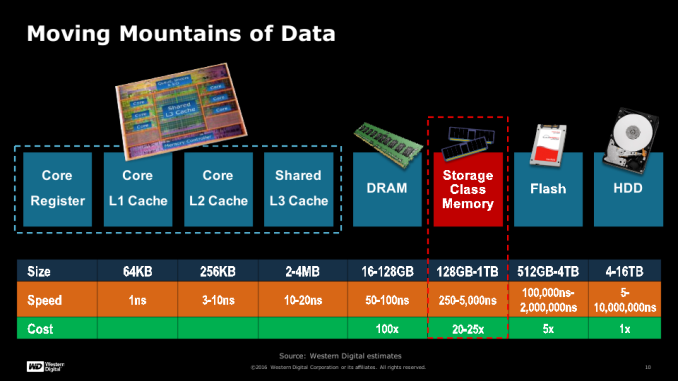
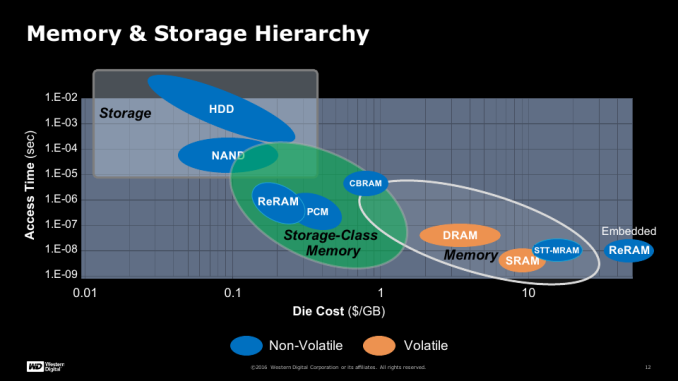

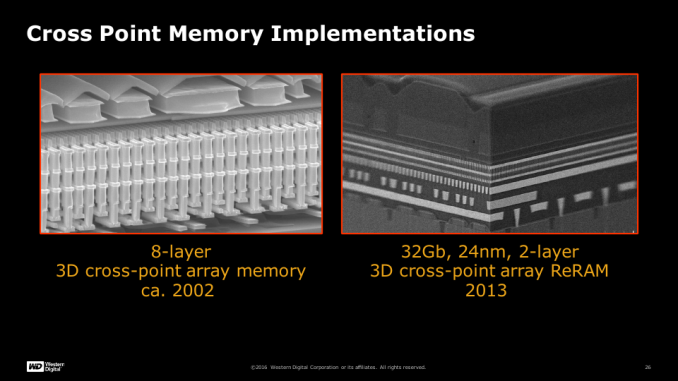
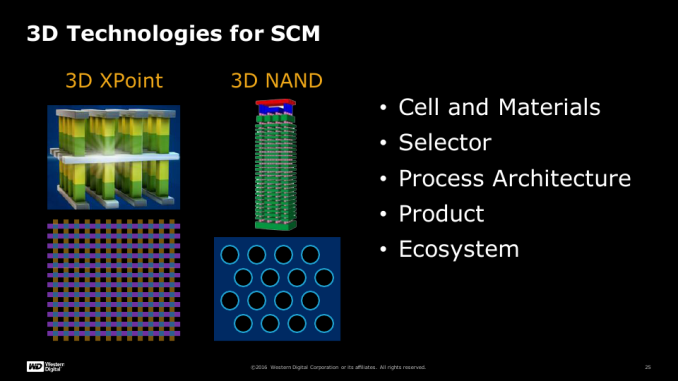
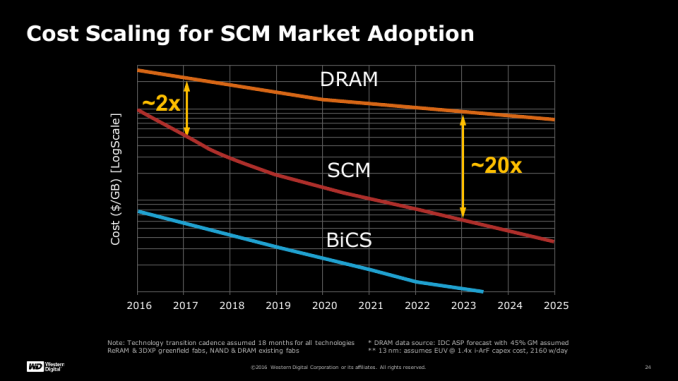














38 Comments
View All Comments
ironargonaut - Monday, August 15, 2016 - link
"stating facts" == "Seems like..." ROFL What fact exactly was it you stated?ddriver - Friday, August 12, 2016 - link
Ops, my bad, you were replying to that other guy. Still, that post will apply to enough people.Michael Bay - Saturday, August 13, 2016 - link
Oh, another one.Xanavi - Friday, August 12, 2016 - link
You really think Intel and Micron will be overshadowed by anyone? LOL. IMO it is under hyped compared to what it can do. Forever retention, ns speed, cheap. It's literally the future.ddriver - Friday, August 12, 2016 - link
I'll believe it when I see it. So far the hints are that xpoint is mostly hype and nothing to get excited about.ddriver - Friday, August 12, 2016 - link
BTW it doesn't boil down to what I *think*, but to what you *believe*. Intel is far from "unbeatable", it currently dominates the desktop and laptop CPU market, a dominance it came to through *questionable* tactics, but Intel is being overshadowed in a number of markets - mobile devices, graphics, ssds, gsm radio, embedded... out of everything Intel makes CPUs is the only thing they are not being vastly out-competed at. And Intel has gotten mediocre and boring at CPUs as well, due to the lack of competition, so their "dominance" in that market is not only product of dirty tactics, but also intrinsic lack of competition. Intel is so depleted they spent billions on acquisitions of companies for their products, which an innovative company could have developed at the cost of millions. It doesn't seem that Intel is doing well in fields it doesn't enjoy a monopoly over.jospoortvliet - Saturday, August 13, 2016 - link
It is true that Intel bought innovation rather than 'do it' but sadly that is what all the big companies resort to - Google, Apple, Microsoft... they rarely innovate. It seems we still have not figured out how to innovate within big companies.Otherwise, yeah, Intel had some dirty tricks but let's be honest - they also simply executed well and their competition blundered. So I don't think they didn't earn their position in the high end market - while I agree with you it has made them complacent. Sadly. I hope arm will continue to give them trouble... And who knows, Zen might be worth the hype.
jjj - Friday, August 12, 2016 - link
XPoint has always been a stop-gap mid-term solution before better technology , like this one, arrives. Micron (and to a certain extent Intel) are working on other things too.Just be cautious about timing for 3D ReRAM and other new memories, it's really hard to make these things and it takes time to sort everything out.
name99 - Saturday, August 13, 2016 - link
I suspect you're misinterpreting the Intel plan. To make maximal use of SCM, you need new cache control (memory flushing/ordering) instructions. It is quite possible Intel only puts these in Xeon E7's, at least for a few years. That doesn't force one to buy Optane, but it does force one to pay a lot to INTEL if one wants to use any SCM well...The real question, then, is how long till either AMD add those instructions to their CPU's, or, more interestingly, till a server class ARMv8.2 CPU is released (since v8.2 likewise contains those instructions).
fanofanand - Friday, August 12, 2016 - link
Yay for not having any standardization! Whoever is able to take advantage of existing interconnects will be the winner, as they should be able to have a significantly lower implementation cost. Of course this should present us with new bottlenecks, hopefully this deluge of new technology will drive the entire industry forward. One can hope right?